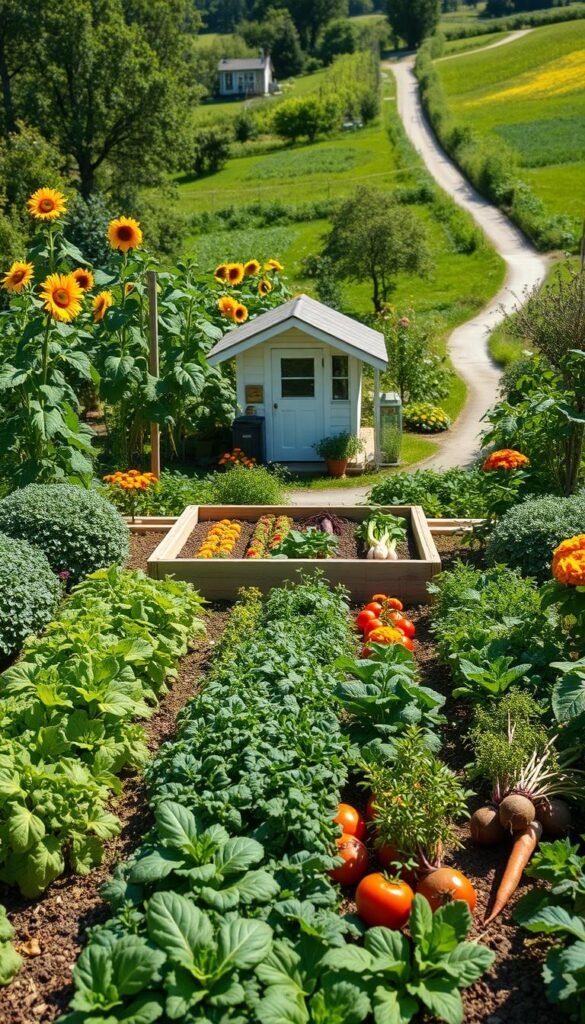Transforming your outdoor area into a thriving food source doesn’t require acres of land—just smart planning. Whether you’re working with raised beds, containers, or a modest plot, the right approach lets you enjoy fresh flavors while nurturing nature’s balance.
Discover how thoughtful design choices create ecosystems where plants support each other naturally. By grouping species strategically and rotating their locations yearly, you’ll maintain soil vitality and reduce pest issues. This method mirrors patterns found in healthy wild landscapes.
Many beginners struggle with dwindling harvests or disease outbreaks. The solution lies in understanding plant relationships and nutrient cycles. For instance, rotating crops in tight spaces prevents soil exhaustion while disrupting insect life cycles—key for sustained productivity.
Did you know? Pairing certain species can boost growth rates and flavor profiles. Tall plants might shelter shade-loving greens below, while aromatic herbs deter unwanted visitors. These partnerships turn limited areas into efficient, self-sustaining systems.
You’ll soon learn to avoid overcrowding, balance sunlight needs, and time plantings for continuous yields. Our guide simplifies these concepts into practical steps, helping you cultivate resilience against common challenges. Let’s build your blueprint for delicious, year-round abundance!
Essential Planning for a Thriving Vegetable Garden
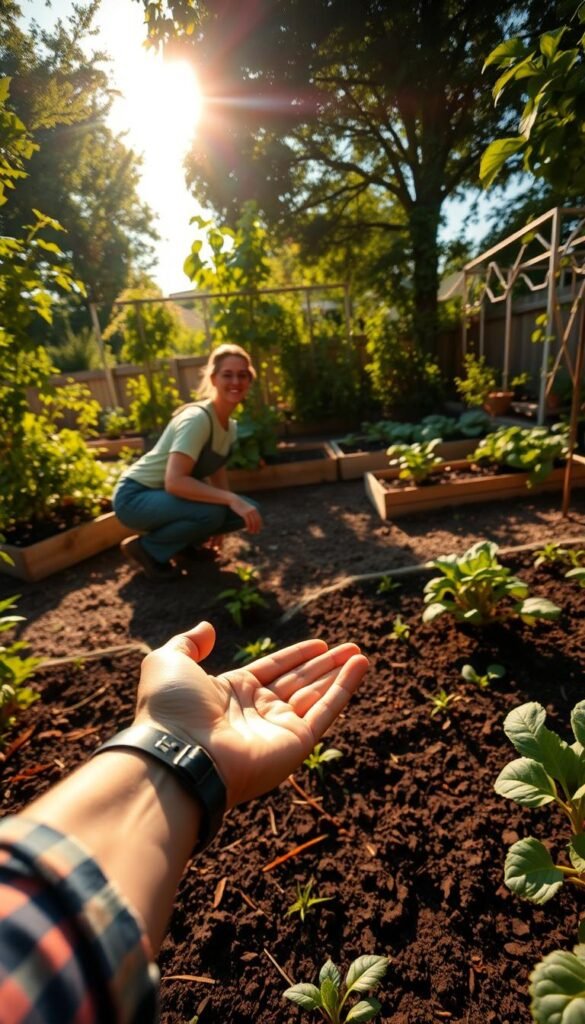
Smart preparation turns limited areas into productive plots. Begin by mapping your land’s sun exposure—most edibles thrive with 6-8 hours of direct light. Use a sun calculator app or observe shadows every two hours to identify bright zones versus shady corners.
Assessing Your Available Space and Sunlight
Measure your plot’s dimensions and note permanent features like trees or slopes. South-facing spots often get the strongest light, while north-facing areas suit leafy greens. Create a simple sketch marking sunlight hours across different sections.
| Sun Exposure | Recommended Vegetables | Daily Light Needs |
|---|---|---|
| Full Sun (6-8h) | Tomatoes, Peppers | Minimum 6 hours |
| Partial Shade (3-6h) | Spinach, Kale | 3-4 hours |
| Full Shade ( | Mint, Chives | 2 hours |
Setting Realistic Gardening Goals
Match your ambitions to your schedule and soil quality. Beginners should start with 3-5 easy crops like radishes or bush beans. If you have limited square footage, focus on high-yield plants like cherry tomatoes.
Test your soil’s pH and drainage before planting. Sandy soils drain quickly but need more watering, while clay holds moisture longer. Record your first frost date and growing season length to avoid crop failures.
Leave pathways wide enough for comfortable movement—18 inches between beds prevents trampling. Consider future expansion by leaving one edge open for additional raised beds or trellises next season.
Designing an Efficient Vegetable Garden Layout
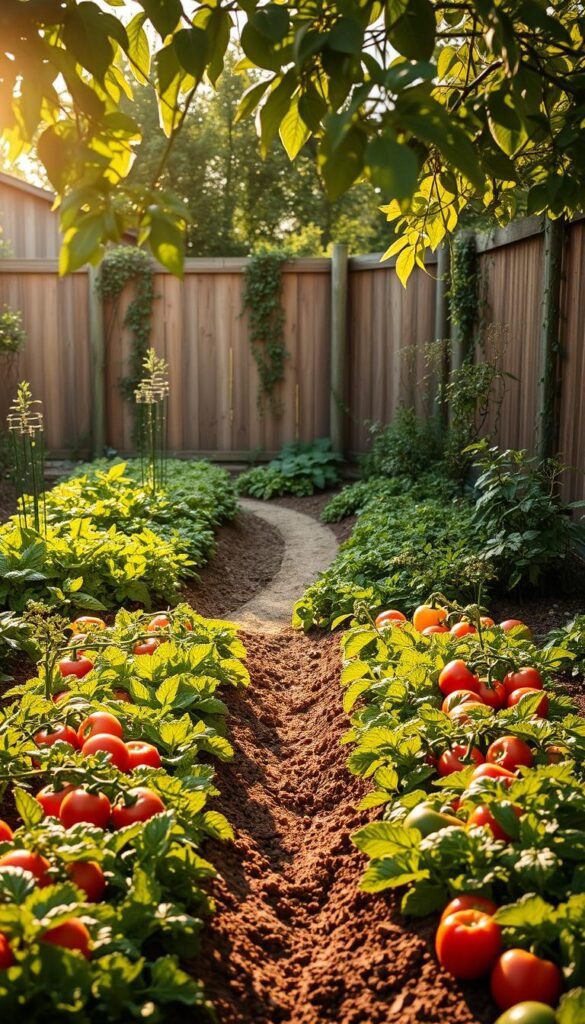
Strategic design choices elevate your growing potential without expanding your footprint. Let’s explore two powerful approaches that transform how you use available areas while supporting healthier plants.
Exploring Traditional Rows and Block Designs
Traditional rows work best for crops needing frequent access, like tomatoes. But most home growers find block planting triples their harvests. Instead of single-file lines, arrange plants in tight grids that leave minimal bare ground.
| Layout Type | Best For | Space Efficiency | Maintenance Needs |
|---|---|---|---|
| Rows | Large root crops | Low | High |
| Blocks | Leafy greens | High | Medium |
Start by sowing seeds closer than recommended, then thin seedlings as they grow. This “plant densely, thin later” method lets you harvest baby greens while giving remaining plants room to mature.
Integrating Vertical Gardening Solutions
Turn walls and fences into productive spaces with simple structures. A sturdy trellis lets cucumbers climb instead of sprawling, while pole beans transform A-frames into edible curtains.
- Use bamboo stakes for peas – they’re affordable and biodegradable
- Train squash vines upward using nylon netting
- Pair climbing veggies with shade-tolerant herbs below
These techniques create layered ecosystems where multiple crops share the same footprint. You’ll discover vertical systems simplify pest control and harvesting too!
Implementing Smart Crop Rotation Strategies
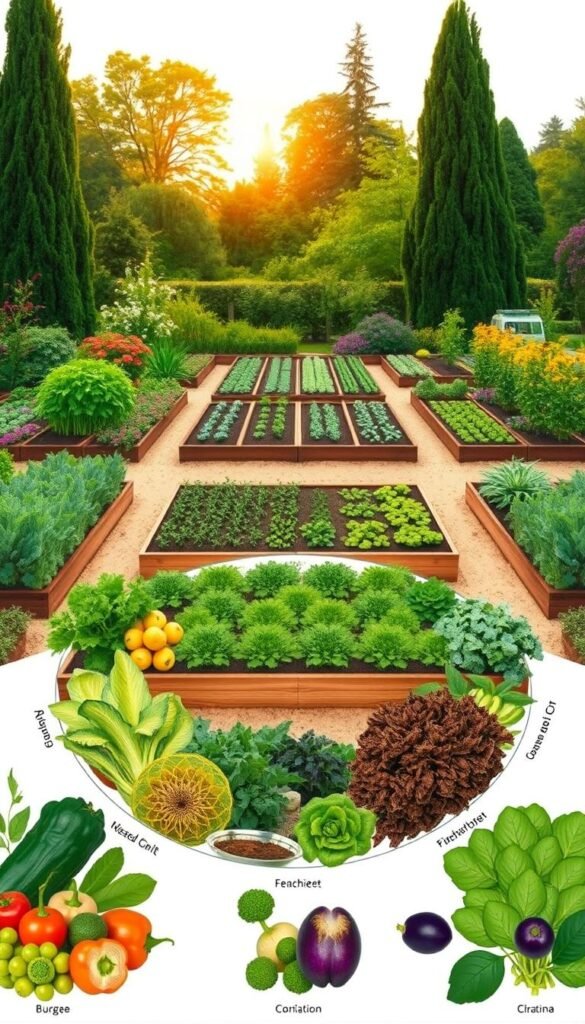
Healthy soil grows more than plants—it cultivates lasting garden success. By rotating where you grow specific crops each year, you create a self-renewing system that outsmarts pests and preserves nutrients naturally.
Understanding the Benefits of Crop Rotation
Think of rotation as nature’s reset button. When the same vegetable family occupies a bed repeatedly, pests memorize its location. Shifting their dinner plate disrupts their life cycles. One study found rotating brassicas (like broccoli) every three years reduced cabbage worm damage by 72%.
Nutrient balance matters too. Heavy feeders like corn drain nitrogen, while legumes replenish it. Pairing them in sequence keeps your soil from becoming exhausted. Light feeders like carrots then thrive in refreshed beds without added fertilizers.
Establishing a Four-Bed Crop Rotation Chart
Divide your growing area into four equal sections. Group plants by family, then rotate them clockwise annually. Here’s a simple 4-year plan:
| Bed Year 1 | Bed Year 2 | Bed Year 3 | Bed Year 4 |
|---|---|---|---|
| Tomatoes, Peppers | Beans, Peas | Leafy Greens | Root Vegetables |
This cycle works beautifully with a square foot garden layout. Track rotations using colored stakes or a digital planner. Remember: nightshades follow legumes, greens follow heavy feeders, and roots finish the cycle before restarting.
By year three, former pest hotspots become inhospitable to bugs that targeted your initial crops. Your soil stays lively, and your harvests grow more robust with each rotation.
Mastering Companion Planting Techniques
Nature thrives on partnerships – and your green space can too. By pairing species that help each other grow, you create living alliances that boost yields while reducing maintenance. This approach works like a botanical buddy system, where each plant contributes unique benefits.
Choosing Beneficial Plant Partners
The radish-carrot duo shows how timing creates harmony. Quick-growing radishes mature in 30 days, marking rows while carrots develop slowly below. When you pull radishes, they aerate soil for expanding carrot roots. This space-sharing strategy lets you harvest two crops from one patch.
Science-Driven Pest Management
Some pairings act like natural bodyguards. Marigolds release chemicals that repel nematodes, protecting tomato roots. Basil planted near peppers confuses aphids with its strong scent. Research from Cornell University confirms these partnerships reduce pest damage by up to 60% compared to monocrops.
- Nasturtiums lure cabbage moths away from broccoli
- Dill attracts ladybugs that devour aphids
- Garlic chives deter Japanese beetles from roses
Focus on proven combinations rather than myths. For example, science-backed plant pairings prioritize nutrient compatibility over folklore. Test partnerships in small sections before scaling up – nature’s teamwork should work for your specific conditions.
Backyard Vegetable Garden Ideas: Layout, Crop Rotation, and Companion Planting
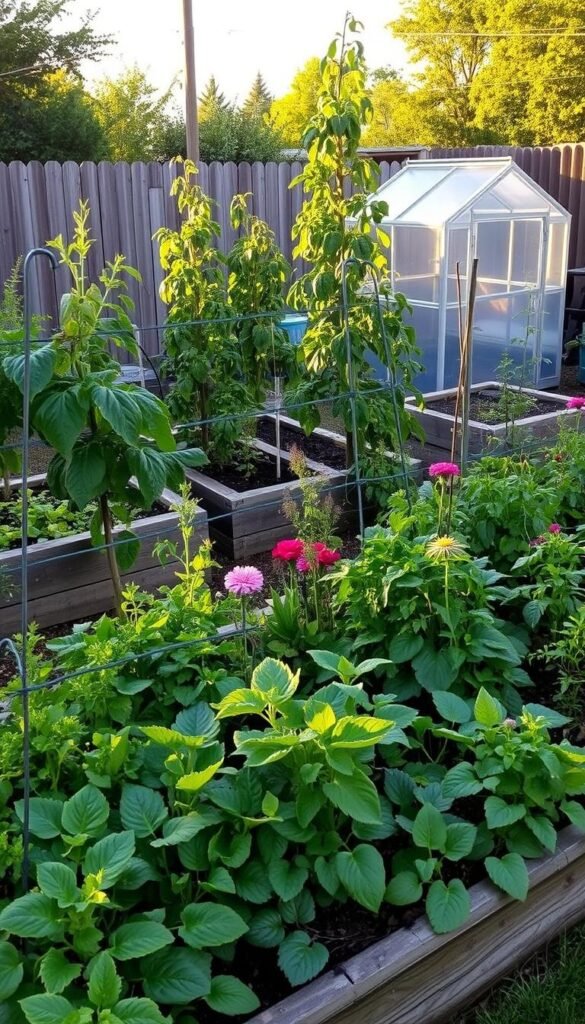
When layout planning, seasonal rotations, and plant partnerships work together, your growing area becomes a dynamic powerhouse. These three strategies form a natural feedback loop—each element strengthens the others while solving common challenges.
Start by dividing your plot into movable zones. Assign plant families to specific sections that shift yearly. Leave extra room between groups for companion pairs like basil-tomatoes or carrots-leeks. This setup lets you rotate crops effortlessly while maintaining beneficial neighbors.
Why does this trio outperform single methods? Consider these advantages:
- Vertical structures support climbing beans one year and cucumbers the next
- Marigolds planted among rotating crops continuously deter soil pests
- Legumes replenish nitrogen for future heavy feeders in the same bed
Smart spacing prevents conflicts. Tall sunflowers might overshadow shorter greens in year one but become perfect pea supports after rotation. For tight areas, compact varieties fit seamlessly into evolving layouts.
Your design should adapt as you learn. Track which partnerships thrive and adjust placements annually. Over time, this integrated approach builds soil health naturally—fewer pests, richer harvests, and minimal extra work.
Innovative Layout Solutions for Different Garden Spaces
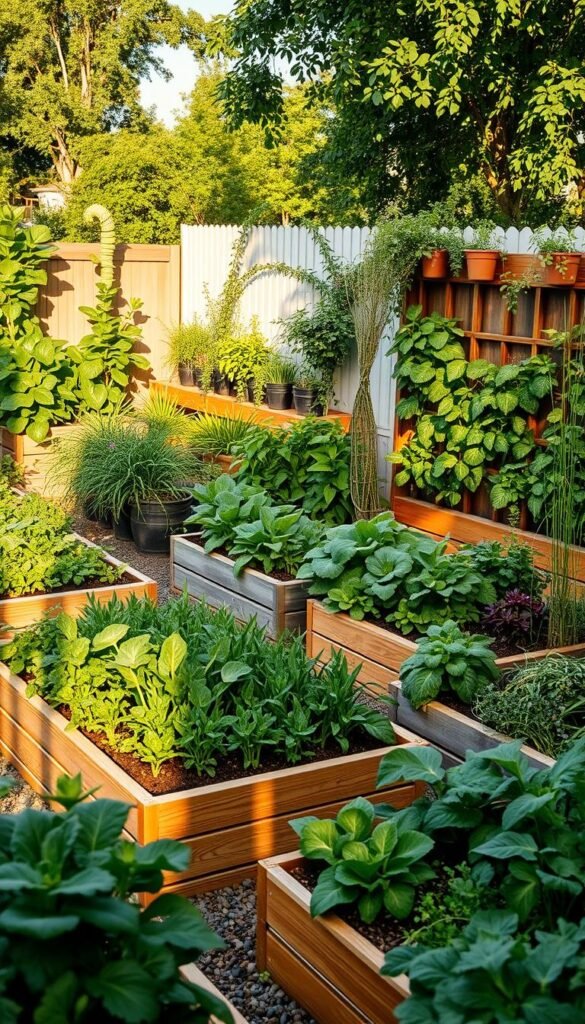
Your growing area’s potential blossoms when you match its unique shape and size with clever organization methods. Let’s explore how different arrangements maximize productivity while keeping maintenance manageable.
Creative Designs for Small and Compact Gardens
The square foot method shines in tight quarters. Divide your plot into 1×1-foot squares—each hosts a specific crop based on its mature size. For example, one square holds 16 radishes but only one tomato plant. This approach simplifies layout plans while preventing overcrowding.
| Method | Best For | Space Used |
|---|---|---|
| Square Foot | Herbs, leafy greens | 90% efficiency |
| Vertical Stacking | Cucumbers, pole beans | 200% yield boost |
| Container Clusters | Patio tomatoes, peppers | Flexible placement |
Customizing Layouts to Suit Your Needs
North-facing row systems work best for sprawling yards. Position tall crops like corn on the northern edge to avoid shading shorter vegetables. In raised beds, try rectangular blocks 3-4 feet wide—you’ll reach all plants without stepping on soil.
Four-section designs simplify crop rotation. Assign each quadrant to a plant family, then shift them yearly. This method pairs perfectly with companion strategies—like growing basil between tomatoes to deter pests naturally.
Remember: successful garden layouts adapt to your daily habits. Leave wide paths if you use wheelbarrows, or include seating areas if you enjoy harvesting while seated. Your space should feel inviting and functional.
Adapting Your Garden for Seasonal Success
Your soil’s potential multiplies when you sync plantings with nature’s calendar. Timing crops to match temperature shifts keeps your plot productive from spring frosts to autumn chills. Let’s explore how to orchestrate this seasonal dance.
Planning for Cool and Warm Growing Seasons
Cool-season stars like spinach and peas thrive when soil hits 40°F. These frost-tolerant varieties yield early harvests before summer heat arrives. Warm-season favorites—tomatoes, cucumbers—demand consistent warmth, so wait until nighttime temps stay above 50°F.
| Season | Temperature Range | Top Performers |
|---|---|---|
| Cool | 40-65°F | Kale, Radishes, Broccoli |
| Warm | 65-85°F | Eggplant, Okra, Melons |
Successive Planting and Harvesting Strategies
Master the art of continuous yields with these tactics:
- Replace harvested garlic with quick-growing bush beans
- Sow lettuce every 14 days for non-stop salads
- Follow spring peas with heat-loving zucchini
Track your first frost date using USDA zone maps. This helps schedule fall plantings of cold-hardy carrots and Brussels sprouts. Pro tip: Use seedling trays to start new crops before clearing spent plants.
By rotating plantings across seasons, you’ll squeeze 3 harvests from the same ground. Your space works smarter, not harder—fresh flavors flow while soil nutrients stay balanced.
Enhancing Garden Beds and Space
Maximizing your green space’s potential starts with refining how you use every inch. Focus on upgrading soil quality and structure first—mix in compost or aged manure to boost nutrients. This simple step improves water retention and root development, especially in raised beds.
Vertical expansions double your growing area without expanding horizontally. Install trellises for climbing beans or cucumbers, freeing ground space for leafy greens. Pair these with drip irrigation systems to conserve water—they deliver moisture directly to roots, cutting waste by 35%.
In warm regions, try adapting square foot techniques with heat-tolerant crops. Use mulch to cool soil and reduce watering needs. Refresh beds annually with 2 inches of compost to maintain fertility naturally.
Rotate plant families yearly to prevent nutrient depletion. Integrate flowers like marigolds between edibles—they attract pollinators while deterring pests. These small tweaks create resilient, high-yield spaces that thrive season after season.

